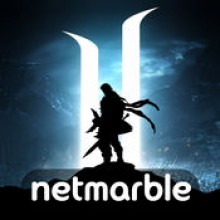Lineage 2: Revolution (iOS) Review
By Thom Compton  31.12.2017
31.12.2017

Hype is a dangerous game. Every industry has, at some point, learned that lesson. Apple's learned it more than once. Coca Cola tried to sell New Coke, and McDonalds flopped with the Arch Deluxe. However, when hype works, it is the ends of a perfect storm of good marketing, solid PR, and an excellent (usually) product. Videogames still have a tough time living up to the hype they often elicit. It's not surprising, since anticipation is all too often better than realisation, which brings things to a game that has been hyped by Conan O'Brien, and has adverts on YouTube of people using pretty standard hype adjectives to get viewers pumped. That game is Lineage 2: Revolution, and with all the talk about it, can it possibly meet the needs of those who pine for it?
Lineage 2: Revolution is an MMORPG from Netmarble that is played on mobile devices. It ticks a lot of the standard boxes: PVP, PVE, and even a series of quests for each player to take as they wish. Crafting is available, daily dungeons, arenas to fight other players… There are literally tons of things to do and experience. The anticipation inside you must be reaching its apex as the idea of a fully-fledged MMO on your phone seeps into your mind. Unfortunately, this review isn't going to be keeping you at that state of bliss, because, when all is said and done, Lineage 2: Revolution doesn't really live up to the hype.
As the player begins, they are introduced to four starting races: Human, Elf, Dark Elf, and Dwarf. Right from the get go, the game begins imposing itself on the player by gender locking each of the races. Humans and Dark Elves are men, Elves and Dwarves are women. While this isn't the end of the world, it does showcase the game's limitations. The player then picks a class, from Warrior, Rogue, and Mystic. Around Level 31, they can complete a series of quests to choose a new class, which is nice in its own way. It's a bit frustrating that the quests aren't available a little sooner, but there are a decent amount of classes available, depending on the chosen race.

This is all following a tutorial that teaches the basic ins and outs of combat. There are two basic control schemes - either use the on-screen joystick, or set the game to auto-play. The joystick feels terrible if the fingers using it are a bit stout, such as with this writer, and it's all too easy to hit the wrong button. For the purposes of this review, then, whenever possible, auto was the control method of choice.
Auto is weird, in that you can auto complete a quest, but the world around you is especially polite about it. Auto completing a quest on the other side of a field of menacing skeletons? Don't worry, as the skeletons will mind their own business. After all, this isn't their problem. It does mean that grinding experience has to be an act specifically sought after (fortunately, for more shiftless gamers, there's an auto button that just has the character fight everything nearby). Furthermore, upon completing the quest, gamers then need to accept the rewards, and then select to auto complete the next quest. It's almost like a clicker, idle-style game that you can't leave idle for more than 30 seconds at a time.
The quests themselves are largely fetch quests or go kill that thing over there ones. Remarkably, with very little side levelling (apart from daily dungeons and a lot of weapon crafting), enemies never really feel all that difficult. Other players do, but the in-game enemies never present any real challenge till near the end of the first area, when the character may well be around level 20. This goes to show one of Lineage 2: Revolution's biggest faults. It's just so grindy. Everything is so incredible repetitive that when you see the Episode Completed text pop up, it's easy to wonder why they even bothered separating any of it.

This rolls into crafting, as well. The more levelled up one is, the more types of crafting they have available; Level Up, Combine - all sorts of options. However, even when levelling up a trusty dagger, it's just a matter of selecting the dagger, then selecting a bunch of other weapons to upgrade it with. So much of the game is spent performing mindless tasks in menus that it's not only repetitive, it gets downright boring.
In-game achievements level up the player's achievement tier, which changes the daily rewards received. However, the leap between each tier is rather high, and even with the more than generous achievements, it can take a while to move between the tiers, so grinding those is in order. The game rewards those who put in the time, but even for a mobile game, that might be asking a lot, especially considering how a lot of that time is spent just grinding and repeating the same actions over and over again. Then, there are the micro-transactions.
Turn the game on, collect your daily reward and it gets sent to a mailbox. Why not to your items, or if it's Adena (one of the in-game currencies), why not to the wallet? Oh, because there are other things in your mailbox, like a special offer on a loot box. One S Grade Weapon, $7.99, instead of $9.99? Hoowah! No, not hoowah. See, Lineage II: Revolution includes many micro-transactions, although you will be fine for quite a while ignoring them. The problem is that if one were to decide to head down that rabbit hole, they would be in for some hurt in the wallet region.
One summon box (loot box) with 10 High-Grade Equipment, for instance, is 1,200 red diamonds. You won't get these often enough to satiate the thirst for whatever's in that box, but it is possible to buy red diamonds. The most diamonds that can be purchased at once is 340 red diamonds, in a pack with 340 blue diamonds. That pack is US$9.99. That means one would need to spend 40 real dollars to purchase enough diamonds to buy the box with random contents in it. Some diamond packs go up to $99.99 (only coming with blue diamonds), and those aren't even the only forms of currency. There's still Loyalty points and Topaz. What happened to Adena?

Worse yet, there are things the game teases you with, like Soulshots. These simply boost attack power, but they have to be turned on. Once on, they quickly burn through, and it's pretty telling how weak one gets once their Soulshots are out. Buy more, then? Why, of course! 500 Soulshots are 5,000 Adena, and 5,000 Soulshots are 45,000 Adena. 500 aren't that many, really; better go for the 45,000. Oh no, wallet's too low, and with this big boss fight coming up, these are going to be essential. Alright, time to buy more Adena with more red diamonds. 42,000 Adena for 200 red diamonds, so that will be… $19.99!
Tirades aside, this is tacky. Yes, players can get through the whole game without spending anything. This doesn't mean these sorts of options don't come across as exploitation, though... and, yes, this is a free game, and keeping servers running is expensive, not to mention updates and paying staff. The problem is the size of these purchases. Since so much of it is arbitrarily assigned to some random in-game currency, it's easy to lose track of how much was really spent in the long run. Remember those horror stories about people accidentally spending thousands on IAPs back in the day? Lineage 2: Revolution is set up in such a way that it could easily encourage that kind of behaviour again.
Beyond all of this, though, it's just a pretty average RPG. Combat's nothing special, and the graphics are merely okay (although the cut-scenes look clunky and highly outdated, even for a mobile device). As for the quests and NPCs, they aren't particularly interesting, nor are they bad. The problem with Lineage 2: Revolution is it's a mediocre grind-fest, hidden under some all too typical free game tropes. It's hard to believe a monthly subscription is actually worse than this.

Cubed3 Rating
Subpar
Lineage 2: Revolution is a reminder that there's a reason some things haven't really been done before. If it weren't for the weird way it approaches IAPs, this would have still only rated slightly higher. It's not particularly exciting, and setting it down almost has a "lifting of weights from one's back" feeling to it. Grinding gets old quickly, and the micro-managing of so many different things is so overwhelming that many might find themselves not even bothering with half of it. The game gives special rewards just for not playing it.

![]() 4/10
4/10
![]() 0
(0 Votes)
0
(0 Votes)
 Out now
Out now  Out now
Out now  Out now
Out now  Out now
Out now Comments
Comments are currently disabled

 Sign In
Sign In Game Details
Game Details Subscribe to this topic
Subscribe to this topic Features
Features





 Top
Top

